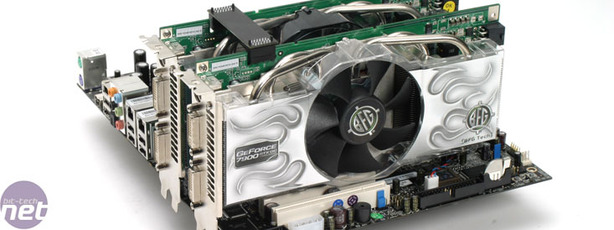The Hardware:
Once the early compatibility problems had been worked out, NVIDIA's SLI platform is easy to install. All that you need to ensure is that you have a pair of SLI-ready video cards and an SLI-approved motherboard, based on one of NVIDIA's SLI-enabled chipsets. We covered the step-by-step installation of a pair of SLI-ready video cards here - obviously the latter stages have changed now, because there is no need to reboot when you enable or disable SLI.Once you have installed the pair of SLI-ready video cards, you need to connect the over-the-top bridge that connects the cards together. The bridge is used to send frame data, and it is also used for NVIDIA's enhanced anti-aliasing modes - known collectively as SLI-AA, which we will come to shortly - on GeForce 7900 and 7600-series cards.
Both ATI and NVIDIA are working towards certifying other hardware, too. This is designed to improve the end user experience - if an end user buys a selection of SLI-certified products, they would expect them to work together and deliver a great end user experience. NVIDIA currently certifies motherboards, power supplies and memory modules. These are all tested by NVIDIA and then given a seal of approval, stating that the products will work together as part of an SLI platform without issue.

Because NVIDIA uses a pair of identical video cards to achieve SLI, there is no need to worry about which PCI-Express x16 slot on the motherboard is the primary and which is the secondary; however, NVIDIA appears to have standardised this, as we are yet to see an SLI-ready motherboard with the primary PCI-Express slot farthest away from the CPU socket.
Rendering Modes:
If we forget about Quad SLI for the time being, NVIDIA uses three specific rendering modes in its SLI technology - these are known as Alternate Frame Rendering, Split Frame Rendering and SLI-AA. The first two are performance-combining modes, while the third is an eye candy-combining mode similar to ATI's SuperAA.Alternate Frame Rendering does exactly what it says on the tin, and works in much the same way as ATI's own AFR method. The two cards render alternate frames, and the secondary video card sends its frame data to the primary card in readiness for displaying on screen. The primary card is responsible for making sure that the frames are displayed in the right order.
Split Frame Rendering works the same way as ATI's Scissor mode, whereby the frame is split in two and load balanced across the two GPUs. This is the mode that NVIDIA focused its multi-GPU push on initially, however, it seems that NVIDIA has found that Alternate Frame Rendering is the better performer in most of the SLI-enabled titles out there. NVIDIA has an option to show load balancing in the older driver control panel - for those that are interested, it's quite cool to watch the drivers dynamically load balance a game across two GPUs. We discussed this in a bit more detail here.
The final rendering mode that NVIDIA uses is SLI-AA. With a pair of GPUs, it is possible to enable up to 16xSLI-AA, with both GPUs using the standard 8xSAA mode with a subsample offset when the final image is combined on the primary GPU. This means that each GPU samples from a slightly different position, giving the overall impression of a much smoother image.
The Limitations:
As with ATI, NVIDIA's multi-GPU platform is held back by its driver team. We don't mean this in a bad way, but ultimately when a new game is released, NVIDIA also needs to release a new driver with an optimised multi-GPU performance profile. Much like ATI, NVIDIA has a work around for getting SLI working in games that aren't SLI-optimised. Using NVIDIA's coolbits registry hack, you can create your own profiles for games that don't have profiles.While this method offers the user a lot more control than ATI's app-rename method, it could also be a downside. The end user can try the various different rendering modes, and NVIDIA provides a guide on how to create your own SLI profiles over on it's SLIZone portal. The more important games get the new driver treatment, but if you're a niche gamer, you may be left on your own for a long time.

MSI MPG Velox 100R Chassis Review
October 14 2021 | 15:04






Want to comment? Please log in.